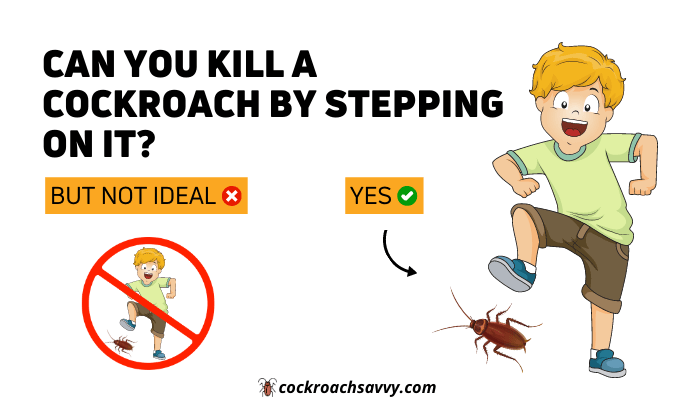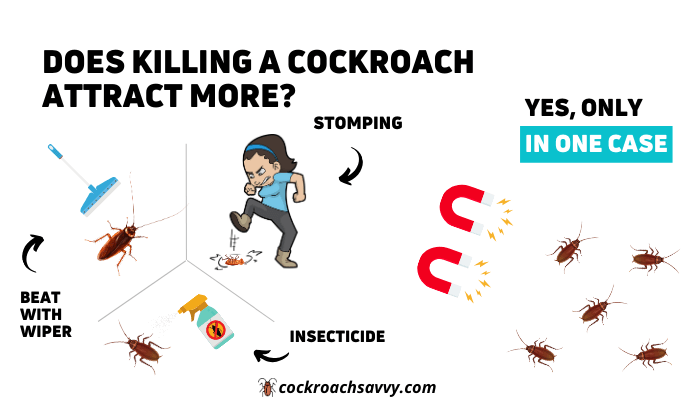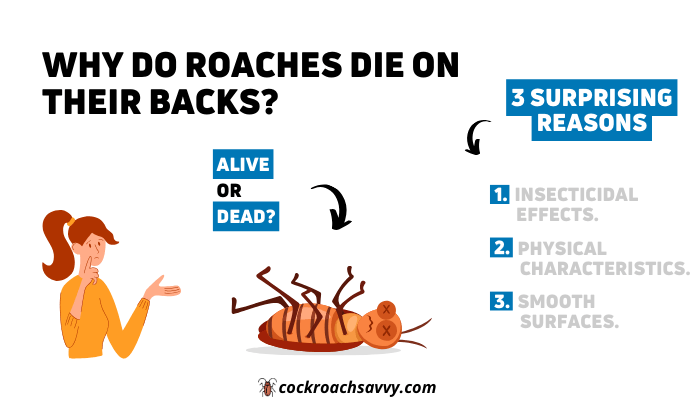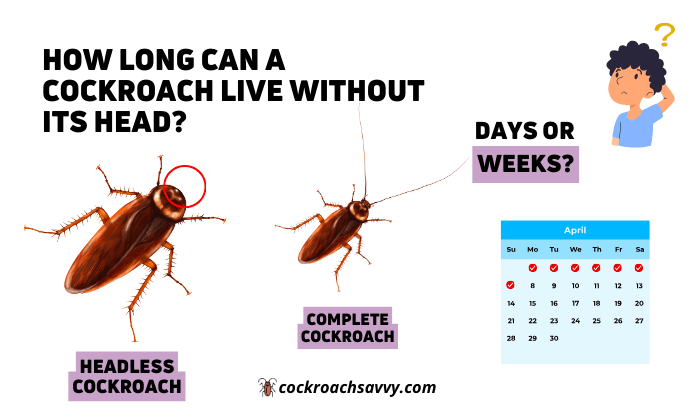When we discuss killing a cockroach by stomping, two types of people come to mind.
- Group 1 – People with katsaridaphobia (Fear of cockroaches)
- Group 2 – People who can stomp them.
Actually, there is one more group of people, but they fall under group 2.
- Group 3 – They have the guts to step on a cockroach, squash, and kill them, but they don’t do it because they hesitate due to some baseless myths.
For example, some believe that squashing a roach will release its eggs, allowing more to hatch.
Others also claim that a crushed roach will give off pheromones that attract other cockroaches, but these are groundless myths.
This detailed article is for the second group of people who have the guts to kill them by stepping on them and the third group.
If you belong to those groups, then continue reading, and if not, then you might be interested in other ways of roach elimination, like natural roach repellents such as peppermint oil.
I am from group second, so let’s continue.
As we all know, cockroaches are some of the most resilient and dreaded pests, and we want to kill them right away the moment we see them.
And,
When we suddenly come face-to-face with one, our first instinct might be to step on it.
But does squashing a cockroach really work, or do they just walk away unscathed?
Let’s explore what happens when you squish a cockroach and disprove some common myths.
Also,
We will explore when we should step on them and when not to use this method, and why.
Can you kill a roach by stepping on it?
Yes, the cockroach will die, but it’s not the same every time you step on them.
It depends on:
- The type of shoes you are wearing.
- The amount of force you apply.
- Your weight.
- And your stepping pattern.
Just stepping on a cockroach might not kill it because of its hard exoskeleton and its ability to withstand a weight up to 900 times its body weight by compressing its body.
You either have to have a weight more than what they can withstand or you have to completely crush their exoskeleton.
Let’s explain these two cases a little bit:
Your weight should be more than the tolerated weight:
As mentioned in this research by the Department of Integrative Biology, University of California, a cockroach’s exoskeletal strength allows it to withstand forces 300 times its body weight when traversing small crevices and up to nearly 900 times its body weight without injury.
So, to crush them, you must have a weight 300 – 900 times more than their weight.
Which is easy, as we weigh more than 900 times the weight of a cockroach.
But let’s do a little math to make ourselves certain:
An average cockroach weighs about 1 gram,
As we know their exoskeleton can withstand 300 to 900 times their body weight,
So that’s 1 gram x 900 = 900 grams,
Which is about 2 pounds (A pretty impressive weight for an organism that has the same weight as a paperclip.)
What we get from the above calculations is that just stepping on roaches with our full body weight will break their exoskeleton and result in their demise.
Now let’s move to the second scenario;
Squash them to Crush their Exoskeleton Completely:
In this option,
If you are using a stick or just your shoes (shoes in your hand) to kill them, you will need to squash them because just putting on a stick or shoes or anything that weighs less than 2 pounds will not kill them.
You will need to squash them.
In the case of stepping on them, you don’t need to squash them, but it’s good to do so because sometimes just stepping doesn’t kill them, and also roaches have another ability – they can compress themselves up to 4 mm from their free-standing height of 12 mm.
To successfully kill them, verify their demise.
Step + Squash + Listen out for a popping sound to indicate that its exoskeleton has cracked.
Can you squish a cockroach?
Although cockroaches have incredibly tough exoskeletons that protect them from getting crushed by ordinary means.
Their exoskeleton, made of a sturdy substance called chitin, provides them with the necessary structure and support for their muscles.
But it’s not something we can’t break.
So yes, we can squash them and end their lives with a force that exceeds their endurance.
When to Apply and Avoid This Method
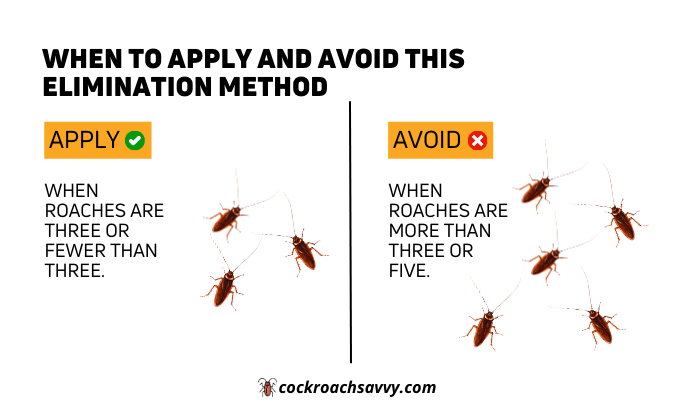
Anything that has pros also has some cons too.
And this method of roach elimination also comes with some cons in addition to its pros.
As we know, we can instantly kill roaches by stepping on them,
But the World Health Organization (WHO) does not allow or advise killing roaches by stepping on them because they state that squashing a cockroach can spread disease.
According to the WHO, which classifies cockroaches as “unhygienic scavengers in human settlements,” squashing them can spread bacteria into the environment that can lead to asthma, allergies, and illnesses.
But I have a solution for this:
How about squashing them and then disinfecting that area with Lysol?
How does this solution sound?
Good?
Hmm?
Okay, let me tell you more.
As the WHO does not advise doing this, I modified this method a little and do it like this:
I use this method of elimination in scenarios where there are three or fewer roaches.
I squash them with my foot and then instantly disinfect that area with a disinfectant.
For more than three or five roaches, I use methods like using smells that repel roaches or peppermint oil,
Because if there are more than three, then it becomes hard to clean every point where you kill a roach.
Although this method has the advantage of verifying their demise, you can’t use this on an infestation or more than five roaches, because the moment you step on your first target (roach), the others will run if they are near to the first one.
Now, let’s learn how to squash them properly and achieve 100% positive results.
How to squash cockroaches?
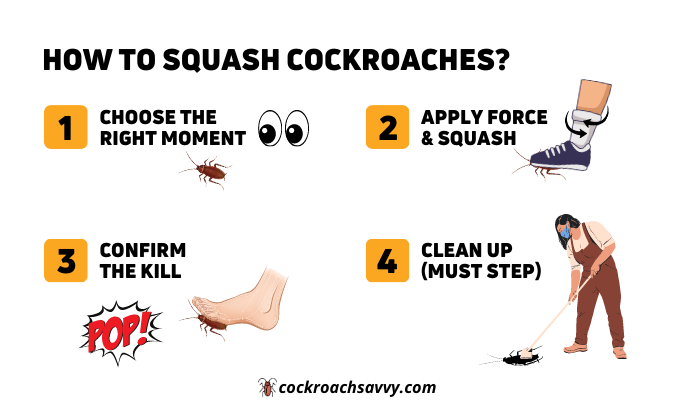
When you see a cockroach, keep these points in mind and execute them:
First, choose the right moment:
Wait for the right opportunity to strike, because cockroaches are unpredictable.
So, be patient and wait for it to slow down or come to a halt.
Apply enough force:
To ensure you squish the cockroach effectively, use enough force to overcome its exoskeleton.
A swift and forceful stomp or a quick, decisive blow with a shoe or other flat, heavy object will do the trick.
When you stomp on roaches, turn your foot first left and right to crush them completely.
Confirm the kill:
After applying force, listen for a popping sound.
This indicates that the cockroach’s exoskeleton has cracked, ensuring a more certain kill.
Clean up (This step is a must):
Once the cockroach is squashed, use tissues or paper towels to pick up the remains and dispose of them in a sealed plastic bag.
Clean the area thoroughly with a disinfectant to remove any lingering bacteria.
This step is a must.
If you are being lazy and not willing to clean the area, please do not use this method, because the leftover body parts will cause you more problems.
What Happens When You Squish A Cockroach?
When you apply enough force and successfully squash a cockroach,
It will die because when you stomp them, the exoskeleton crushes, allowing the internal organs to be crushed, which leads to their demise.
One more thing:
When you successfully squash a cockroach, it can spread disease.
As they are classified as “Unhygienic scavengers in human settlements” by the WHO (World Health Organization), they secrete a white substance, often confused with cockroach milk, but it’s actually their blood.
Yes, cockroaches have white blood because they lack hemoglobin (a red protein responsible for transporting oxygen in the blood of vertebrates)
It’s important to mention here:
Many people also think that when we squash a cockroach or when they die, they release pheromones and think that they attract other roaches.
But the truth is:
Cockroaches do release a pheromone upon death, but it’s a warning, not an invitation.
Roaches will avoid other dead roaches unless they’re starving.
More on this is discussed later in the article under “Does squashing a cockroach attract more?”
Now, more questions might arise in your mind, such as:
What Happens If I Only Squash Half a Cockroach?
Squashing a half and leaving the other half uncrushed doesn’t make any sense because you never want to leave the cockroach alive.
But this question probably comes to mind while discussing squashing a cockroach.
So, why not have a little look at this curious scenario and know the unexpected consequences of partial squashing.
Cockroaches have an intriguing secret – they have not one, but two brains.
One is in their head, and the other is in their back.
The brain located in the head is in charge of:
- Senses
- Memory
- Limb regeneration
- Suppressing reproductive behavior
- Hormone secretion
While the second brain located in the posterior is regarded as a rudimentary brain and controls:
- Sexual activity
- Sensory information
- Maternal instincts
- Triggering apparent death behavior
This unique anatomy leads to two fascinating phenomena when only half of a cockroach is squashed.
Phenomena #1: What If I Crush The Head Of A Roach?
Interestingly, a cockroach can survive for a limited time without its head.
Despite lacking the direction of the head brain, the secondary brain takes over and enables the roach to exhibit certain behaviors, such as attempting to copulate.
However, this half-squashed roach is destined for a unique fate – it survives for a brief period and ultimately succumbs to starvation.
Phenomena #2: What If I Crush The Butt Of A Roach?
On the flip side, squashing a cockroach’s posterior has distinct consequences.
The secondary brain’s vital role in sensory cues and coordination becomes evident as the roach’s ability to navigate and find shelter falters.
Without the guidance of the second brain,
The cockroach fumbles around aimlessly, struggling to discern obstacles and ultimately facing the grim prospect of either starvation or predation.
What happens if you step on a cockroach barefoot?
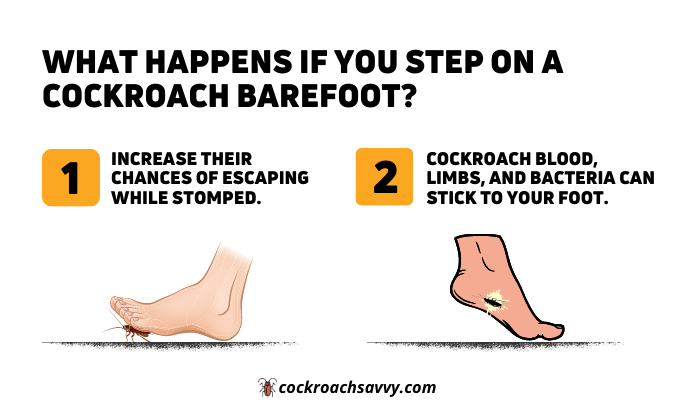
Stepping on a cockroach with your bare foot might not be the most pleasant experience, but if done with enough force, it can kill the roach.
However, this is something I would never do myself, and I strongly advise against attempting it.
Here’s why:
Increase their chances of escaping while stomped:
Cockroaches are incredibly agile and possess a remarkable ability to contort their bodies.
When subjected to the pressure of a foot, they can skillfully navigate the tread’s contours, potentially slipping away from the impact.
This unexpected flexibility could result in the cockroach escaping, leaving you with a less-than-pleasant surprise underfoot.
Cockroach Blood, limbs, and bacteria can stick to your foot:
In the unfortunate event that you do manage to squash a cockroach, the aftermath might be messier than you anticipate.
Cockroach blood, fragments of limbs, and potentially harmful bacteria from the roach’s body could adhere to your foot.
This could pose hygiene concerns and even lead to skin irritation or infection.
While your skin acts as a natural barrier, the possibility of bacterial transfer remains a valid reason to avoid squashing cockroaches with your bare feet.
Do cockroaches release eggs when squashed?
Most people believe that squashing a cockroach can release its eggs,
But that’s not true;
It is just a myth.
Most roaches don’t carry their eggs with them; instead, they lay eggs in hidden crevices.
So, you need not worry about unintentionally spreading roach eggs by squashing one.
Dispelling the Myth: Most Roaches Don’t Carry Their Eggs
Contrary to popular belief, squashing a cockroach won’t lead to the release of its eggs.
Most cockroach species have a different strategy for safeguarding their eggs – they lay them in hidden, secure locations.
Female cockroaches typically carry their eggs in an ootheca, a protective casing made of a tough, chitin-like substance.
These egg cases are constructed to endure a variety of challenges and are usually deposited in small, damp crevices.
Stepping On A Cockroach Kills The Eggs Too:
In the rare instances where a cockroach might carry its eggs externally, the outcome is quite different.
If you accidentally step on a roach of this variety, the eggs will indeed be crushed along with the roach’s body.
The robustness of the egg cases might protect them from various external factors, but they are no match for the weight and force of a human foot.
In this scenario, the unborn roaches within the eggs are unlikely to survive the encounter.
Eggs Surviving the Squash – The Unlikely Scenario:
Let’s entertain the unlikely notion that a couple of eggs manage to survive being squashed.
Even in this improbable situation, the fate of these eggs is grim.
Without the comfort of their protective egg cases or the nurturing environment of their hiding spots, these eggs would struggle to complete their development.
The absence of their usual shelter would likely hinder their molting cycle and overall growth, ultimately leading to their premature demise.
The Mystery of the Empty Ootheca:
There’s an additional twist to the tale.
Sometimes, what appears to be an ootheca – the egg case – attached to a female roach might be empty.
Ootheca have a small ridge along their sides, which roaches breakthrough when it’s time for the nymphs to hatch.
Once the nymphs emerge, the ridge closes itself back up.
So, after squashing a cockroach and spotting what seems like an egg case, rest assured that it might be empty and therefore poses no egg-related concerns.
Do cockroach eggs stick to your shoe?
First of all, most cockroaches don’t carry their eggs with them.
And, in the second rare scenario, if the female roach does have eggs, they are crushed along with the roach.
So, NO, cockroach eggs don’t stick to your shoe in either of the above scenarios.
Does squashing a cockroach attract more?

Contrary to popular belief, roaches do release pheromones when they die, but that’s not an attractive pheromone.
The Pheromone Mystery – What Really Happens:
When a cockroach meets its demise, it does release a pheromone – a chemical signal that conveys information to other roaches.
However, the purpose of this pheromone is quite different from what popular belief suggests.
Rather than acting as an invitation for more roaches, it serves as a warning of danger.
The scent essentially communicates to other roaches that an area is potentially hazardous due to the presence of a threat – in this case, a squashed roach.
Pheromone, role is communication.
But we don’t know what the pheromone was released for; it can signal danger, mating, nest-making, etc.
Let’s discuss two related topics:
Nest-Making vs. Danger Avoidance:
Cockroaches communicate through a complex system of pheromones, which play a crucial role in various aspects of their lives, including finding suitable nesting sites.
When a cockroach identifies a favorable location for nest-building, it releases specific pheromones to signal its discovery to others, prompting them to consider the area as a potential home.
However, the scenario shifts when a cockroach meets its demise.
The pheromones released upon death signal an entirely different message – one that urges other roaches to steer clear rather than congregate.
This instinctual response to the pheromone acts as a survival mechanism, enabling roaches to avoid potential threats and safeguard their own well-being.
Scientific Insights into Roach Behavior:
Biologist David Rollo of McMaster University conducted research shedding light on this phenomenon.
His team discovered that the pheromones emitted by crushed cockroach parts deterred live roaches from approaching those areas.
This finding contradicts the idea that killing a cockroach leads to more roaches gathering.
The release of oleic acid and other cuticular hydrocarbons (Grouped as pheromones) from a dead roach serves as a type of “necromone.”
Necromones are chemical signals released by dead insects that act as a warning or alarm to other members of their species.
In the case of roaches, necromones signal danger and death.
When living roaches detect the presence of these necromones, including oleic acid, they change their behavior to avoid the area where the dead roach is located.
This behavioral response is crucial for their survival, as avoiding the location of a deceased individual helps reduce the risk of encountering potential dangers or threats that might have caused the death.
Conclusion:
I hope a lot of your myths and misconceptions are now dispelled, and you have gained many new facts about squashing cockroaches and how to do it the proper way with the most success after reading this article.
I, too, believed many myths about squashing roaches and would be afraid to get rid of them through squashing before doing research for this article and experimenting with it.
But now I can squash them easily.
Keep SQUASHING EM! – Ba-bye.
FAQS
Do Cockroaches Die When You Step On Them?
Yes, cockroaches can die when you step on them, but their tough exoskeletons make it challenging to deliver a lethal blow without sufficient force.
Why Do Cockroaches Pop When You Step On Them?
Cockroaches pop when you step on them because your applied force exceeds the force (900 times their body weight) that their exoskeleton can tolerate.
This leads their thick and hardy exoskeleton to crack and causes them to lose control of their muscles.
How to clean up dead roaches?
Cleaning up a deceased cockroach requires proper handling for hygiene and to prevent potential contamination:
Preparation:
Wear disposable gloves to avoid direct contact with the roach and any potential germs.
Supplies:
Get a paper towel or tissue to pick up the roach.
Disposal:
Place the roach in a sealable plastic bag or container.
Sanitize:
Clean the area where the roach was found with a disinfectant.
Wash Hands:
After cleanup, remove gloves and wash hands thoroughly.

